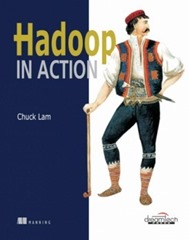Book review: Hadoop in Action by Chuck Lam
 Hadoop in Action by Chuck Lam provides a brief, fairly technical introduction to the Hadoop Big Data ecosystem. Hadoop is an open source implementation of the MapReduce framework originally developed by Google to process huge quantities of web search data. The name MapReduce, refers to dividing up jobs amongst multiple processors (“Mapping”) and then recombining results to provide an answer to the problem (“Reducing”). Hadoop, allows users to process large quantities of data by distributing it across a network of relatively cheap computers. Each computer in the network has a portion of the data to process, and at the end it is combined together to give the final reult. Hadoop provides the infrastructure to enable this. In a sense it is a distributed operated system which provides fundamental services to applications such as Hive and Pig.
Hadoop in Action by Chuck Lam provides a brief, fairly technical introduction to the Hadoop Big Data ecosystem. Hadoop is an open source implementation of the MapReduce framework originally developed by Google to process huge quantities of web search data. The name MapReduce, refers to dividing up jobs amongst multiple processors (“Mapping”) and then recombining results to provide an answer to the problem (“Reducing”). Hadoop, allows users to process large quantities of data by distributing it across a network of relatively cheap computers. Each computer in the network has a portion of the data to process, and at the end it is combined together to give the final reult. Hadoop provides the infrastructure to enable this. In a sense it is a distributed operated system which provides fundamental services to applications such as Hive and Pig.
At ScraperWiki we’ve had many philosophical discussions about the meaning of Big Data. What size is Big Data? Is it one million lines? Is it one billion lines? Should we express it in terms of gigabytes and terabytes rather than lines?
For many, Big Data is data that requires you use Hadoop or similar to process.
Our view is that Big Data is data big enough to break the tools or hardware you commonly use, so for many of our customers this is a software limit based on Microsoft Excel. Technically Excel can handle a million or so lines but practically speaking life gets uncomfortable as you go above a few tens of thousands of rows.
The largest dataset a customer has come to us with so far is the UK MOT test data – results of the roadworthiness test for every vehicle on the road in the UK, over three years old. This dataset is about 100 million lines and 4 gigabytes per year, it’s available back to 2005 giving a total of approximately 1 billion lines and 32GB. A single year can be readily analysed on an Intel i7 laptop with 8GB RAM, MySQL and Tableau by readily I mean that some indexing jobs can take up to an hour but once indexed most queries are 10 – 20 minutes maximum.
At ScraperWiki a number of us have backgrounds in the physical sciences where we’ve been interested in computational intensive simulations involving clusters of commodity hardware which pre-date Hadoop (Beowulf), or big data from the Large Hadron Collider. Physical scientists have long been interested in parallel computing where the amount of data to move around is small but the amount of calculation to do is large. The point here is that parallel computing is possible for a subset of problems where a task can be divided up into smaller chunks of data and processing to be distributed amongst multiple processors or machines. In the case of photorealistic computer graphics rendering this might be frames of video, or a portion of a whole scene. Software like Matlab, Fortran and computer graphics renderers can parallelise certain operations with relative ease. The difficulty has always been turning your big computing problem into one of those “certain operations”. The Large Hadron Collider is an example more suited to the Hadoop style approach, the data flows are enormous but the calculations performed on that data are, comparatively less troublesome.
Hadoop in Action spends a significant amount of time discussing the core Hadoop system and MapReduce processing framework. I must admit to finding this part rather dull. I perked up when we reached Pig, described as a data processing language and Hive, a SQL-like system. One gets the impression the Pig system was built around a naming convention pushed too far: the Pig commandline is called Grunt and the language used by Pig is Pig Latin. Pig and Hive look like systems where I could sit down and run some queries with a language looks like my old friend, SQL.
The book finishes with some case studies, these are an image conversion problem, machine learning and data processing at China Mobile, the Stumbleupon social bookmarking system and providing search for IBM’s intranet. In the latter three cases users were migrating from SQL based systems running on monolithic hardware. To give an idea of scale: China Mobile collect terabytes of data per day across 100s of millions of customers, the IBM intranet has something like 100 million pages and 16 million documents and Stumbupon has 25 million users clicking their Stumble buttons about 1 billion times in a month.
Overall, a handy introduction to Hadoop although perhaps oddly pitched – it’s probably too technical for most managers, not technical enough for system administrators and with insufficient applications for data scientists. If you want to get hands on experience of Hadoop, then the Hortonworks Sandbox provides a pre-packaged virtual machine with a web interface for you to try out the various technologies.
If you want us to help you get value out of your big data or even Big Data, please get in touch!
